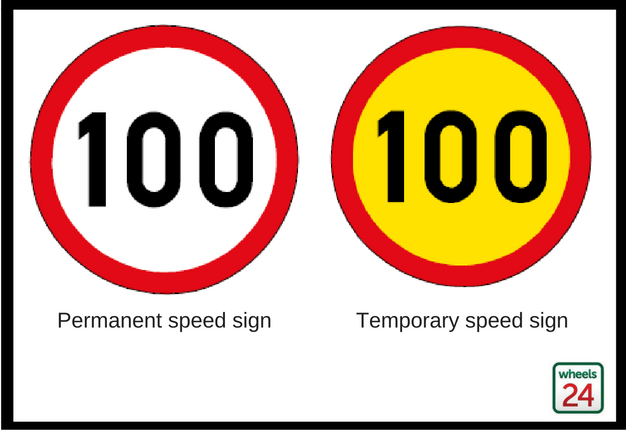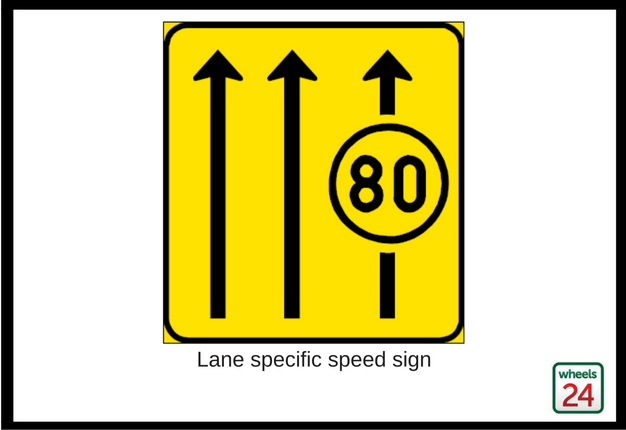Cape Town - When driving on the highway or any road, speed signs are placed alongside the tarred surface. Sometimes there’ll be a 120km/h-sign with a red circle or an 80km/h-sign with a blue circle.
The different meanings of these colours are sometimes unknown to motorists and road users, with many continuing to drive in the incorrect lane at the wrong speed.
This not only infuriates faster road users, but it also shows little disregard for the laws of the road.
Wheels24 approached Howard Dembovsky, national chairman of Justice Project South Africa (JPSA), for comments on what road users can and should do when dealing with different speed signs.
1. Wheels24: What is the meaning of the colours?
JPSA: When contemplating speed, motorists should remember that the general speed limit applies to all roads in South Africa and where there is no sign regulating it to a different speed limit, the general speed limit applies.
To recap, these general speed limits are:
• 60km/h on a road within an urban area;
• 100km/h on a road outside of an urban area; and
• 120km/h on a freeway only.
A permanent speed limit sign is white in colour with a red border and black numbers and a temporary speed limit sign is yellow in colour with a red border and black numbers like this:
Both of the above mean exactly the same thing - the speed limit displayed is the speed limit which is applicable and both are prohibition signs, meaning you may not exceed that speed limit.
A minimum speed sign is blue with a white border and numbers and its temporary version is yellow with a black border and numbers like this:
Both of the above mean exactly the same thing - where this sign is displayed, no vehicle may drive at a speed lower than the speed displayed, regardless of which lane they are driving in.
Lane specific speed limit signs also exist as follows and must be obeyed:
What is important to note is that a temporary speed sign is NOT a “recommended speed limit”. Like all temporary signs, it has the full force and effect of its permanent counterpart.
What is your experiences with the different speed signs? Email us or get in touch via Facebook and Twitter.
2. Wheels24: When can you drive in the 'slow lane' below recommended speed?
JPSA: There is no such thing as the 'slow lane' or the 'fast lane' on any road, including a freeway. There is also no such thing as the "recommended speed”.
The minimum speed sign is a command sign, meaning that you must drive at a speed greater than that which is displayed - no exceptions.
3. Wheels24: Does flashing your hazards make it OK to drive in the left lane?
JPSA: No. Firstly, you may not drive with your hazard lights on unless it is an emergency. And secondly, driving with your hazard lights on is dangerous since it prevents you from signalling any intention to change direction.
4. Wheels24: Can you drive above 80km/h in the right lane, but below 120km/h?
JPSA: Speed differential of vehicles travelling in the same direction is the single biggest risk factor on freeways and just as much as you can cause a collision because you are driving too fast, you can also cause one because you are driving too slow.
Freeways are designed to be high speed links between different destinations and should be used as such - not for a “Sunday drive”.
In keeping with the “keep left - pass right” rule the lanes on freeways should be used as graduated speed lanes and the outer lane which you call the “fast lane” should only be used for passing the fastest moving traffic in the lane adjacent to it. Once that passing manoeuvre has been completed, you should move back to the lane immediately adjacent to the outer lane.
5. Wheels24: How can the number of drivers who are driving at the wrong speed in the 'incorrect' lane be minimised?
JPSA: Quite frankly, the only practical way this can happen in the absence of proper law enforcement is if people begin to think like reasonable human beings and start exercising some courtesy to others on the road. That’s a big ask and it’s becoming a bigger one with every day which goes by since in my observation, South African drivers are becoming more and more inconsiderate towards others as time passes.
There is another thing that could be done and that would be for traffic authorities to begin enforcing moving violations properly, but this is also a very big ask. Sadly our traffic authorities appear to be interested in only enforcing exceeding the speed limit instead of enforcing speed inappropriate for the circumstances which includes driving too slowly.
To be fair, there have been a few instances where traffic authorities have stopped people who were driving too slowly on a freeway and in a number of these cases, it has emerged that the driver in question was hammered out of their skulls (driving under the influence of alcohol).
What is your experiences with the different speed signs? Email us or get in touch via Facebook and Twitter.
6. Wheels24: What does the law say?
JPSA: The law says very little with respect to driving on freeways, however it does cater for those overtaking in the outer lane to flash their headlamps at the driver in front of them to request that they make way and that the driver at whom headlamps are flashed shall move over to the left as soon as it is safe to do so.
This is not an optional provision - that driver must move over to the left as soon as it is safe to do so. See Regulation 323(5) and (6) of the National Road Traffic Regulations, 2000.
Regulation 323 - Special provisions applicable to freeways:
(5) Where the driver of a motor vehicle which is being driven in the right-hand traffic lane or in the traffic lane furthest to the right on a freeway (hereinafter referred to as the first vehicle) becomes aware that the driver of another motor vehicle (hereinafter referred to as the second vehicle) intends to overtake the first vehicle, the driver of the first vehicle shall steer that vehicle to a lane to the left of the one in which he or she is driving, without endangering himself or herself or other traffic or property on the freeway, and shall not accelerate the speed of his or her vehicle until the second vehicle has passed.
(6) For the purposes of subregulation (5) the driver of the second vehicle may make the driver of the first vehicle aware that he or she intends to overtake the first vehicle by giving the driver thereof a visible signal by means of flashing the headlights of his or her vehicle.
It is important to be aware that even if you are driving at the speed limit, you may not fail to move over because you feel that it is your job to enforce speed limits - or any other traffic laws for that matter. You are obliged to move over, regardless of what speed you are travelling at.
What is your experiences with the different speed signs? Email us or get in touch via Facebook and Twitter.




 Publications
Publications
 Partners
Partners

















